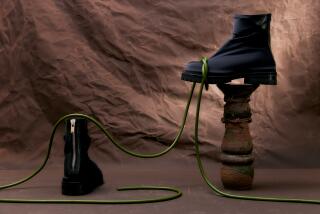Menswear takes on a cocooning cast: way easy and relaxed
- Share via
Milan, Italy
WITH the sorry state of the global economy and the escalating cost of gas, why even bother changing out of your pajamas at all? Why not punch out, cocoon in your geodesic dome, dig in your garden, go on a Bohemian safari, become a peripatetic nomad, neo-hippie or wandering gypsy and wave the wrinkled, white cotton flag of sartorial surrender?
That was the sentiment behind the spring men’s collections that wrapped up here Tuesday. Most designers thumbed their noses at the traditional corporate dress of the pinstriped hedge fund managers and CEOs who got us into this mess in the first place. Clothes that weren’t being cut into high-priced PJs were steamrolled, crumpled and dismantled from the inside out, subjected to the same pressure as the men wearing them. Based on the number of denuded necklines, not only will the necktie -- the symbolic yoke of the working stiff -- be extinct by next summer, but the shirt collar and jacket lapel are on their way out too.
As Ed Park writes in the opening lines of his new novel of office satire, “Personal Days”: “We dress like we don’t make much money, which is true for at least half of us.”
Dolce & Gabbana were on top of the pajama game with double- and single-breasted pajama-print jackets with contrast piping, generously proportioned drawstring trousers that overflowed at the ankles and kimono-inspired bathrobes. A denim tuxedo paired with chunky mandals? A suit crafted out of micro-dot-patterned necktie fabric? On the surface they’re fun twists on classic menswear; underneath they’re the perfect embodiment of the new casual/luxe vibe.
Bottega Veneta came to the slumber party too, albeit with more subtlety. In doing so, creative director Tomas Maier sent out one of the most enjoyable and wearable collections of the week. Calling it the “single most versatile item in a man’s wardrobe,” Maier focused on the jacket, from light cotton striped styles akin to pajama tops, to more constructed, peak-shouldered, knit jersey blazers. Trousers were also a relaxed, sleepwear-inspired affair, generously cut in comfortable cottons.
At Burberry Prorsum, Christopher Bailey took a different approach to the wardrobe of economic protest. Instead of shuffling off to bed, he headed out to the garden. Under a clear roof that made the show venue look (and, unfortunately, feel) like a giant greenhouse, Bailey was inspired by his love for gardening as well as the late British filmmaker Derek Jarman, who famously built a garden near Britain’s Dungeness nuclear power station.
If it sounds like a somber, up-the-establishment premise, it was. Bailey’s “crumpled classics” -- drop-shouldered, wrinkle-washed cotton outerwear; scoop-necked knitwear; gathered trouser waists; puckered cardigans; and battered gardening hats -- were the sartorial equivalent of a defeated soul collapsing in on itself. On the bright side, it is hard to see how they could be anything but the ultimate in worn-in comfort.
Dude décolletage
Miuccia Prada, who pilfered the pajama drawer a year ago, revisited the theme only briefly with a few polos that resembled nightshirts, worn with boxers. Mostly, she focused on the future, one apparently in which men wear halter-top hoodies that expose them from rotator cuff to rotator cuff and down to the breast bone, forming a triangle of man cleavage.
Asked about the parade of dude décolletage, Prada said, with a twinkle in her eye, “Men have it, they just don’t show it very often.”
More traditional pieces included short-waisted jackets with sleeves rolled up, many with stiff, exaggerated creases and outlines of nonexistent ghost buttons that suggested the presence of intense pressure. Here, as at Dolce & Gabbana, the offerings included a full-denim suit. It may be a corporate silhouette, but it’s cut from the working man’s cloth, making it the ultimate commentary on high/low fashion. Several lads wore baggy boxers, voluminous tank tops and wide-necked shirts or trench coats, all in white, paired with black dress socks and shoes, looking as if they had been stripped of their workaday wardrobe and sent packing, or that they’d given up their suits in protest.
The protest from Versace was against not only the necktie but also the collar itself. Over the last few seasons, Donatella Versace and Alexandre Plokhov have been tweaking the traditional notion of the jacket lapel. This time, a pinstriped suit had lapels but no collar, while a black jacket had not one but two sets of lapels. This “formal attitude, informal mind-set” requires something dressy in the accessories arena, and Versace’s answer to the tie is a narrow scarf of colored silk worn loosely knotted around a bare neck. It was California casual through a Versace filter, and it doesn’t take much to imagine the pushed-up sleeves, loose collars and sandaled feet tucking into a table at the Ivy.
Early press reports buzzed with news that Donatella had dedicated her collection to Barack Obama, and one of the snappy, no-collar jackets could only improve on the ill-fitting collars that have left the junior senator looking more junior high school kid in his big brother’s hand-me-downs than potential leader of the free world.
Alexander McQueen lives to thumb his nose at The Man, and he didn’t disappoint, sending out a collection of body-hugging and thought-provoking garments that used flesh-tone color-blocking to create the illusion of bandaged, shirtless or bustier-wearing men.
Distinctive wisps of cigarette smoke were Jacquard woven into shirts and jackets to appear as if they were curling across the garments, an effect McQueen said took three months to perfect. “It’s that whole smoke-and-mirrors feeling like when you go into a club and it’s all misty and sexy,” McQueen said, adding: “And that makes it a smoking jacket, doesn’t it?”







